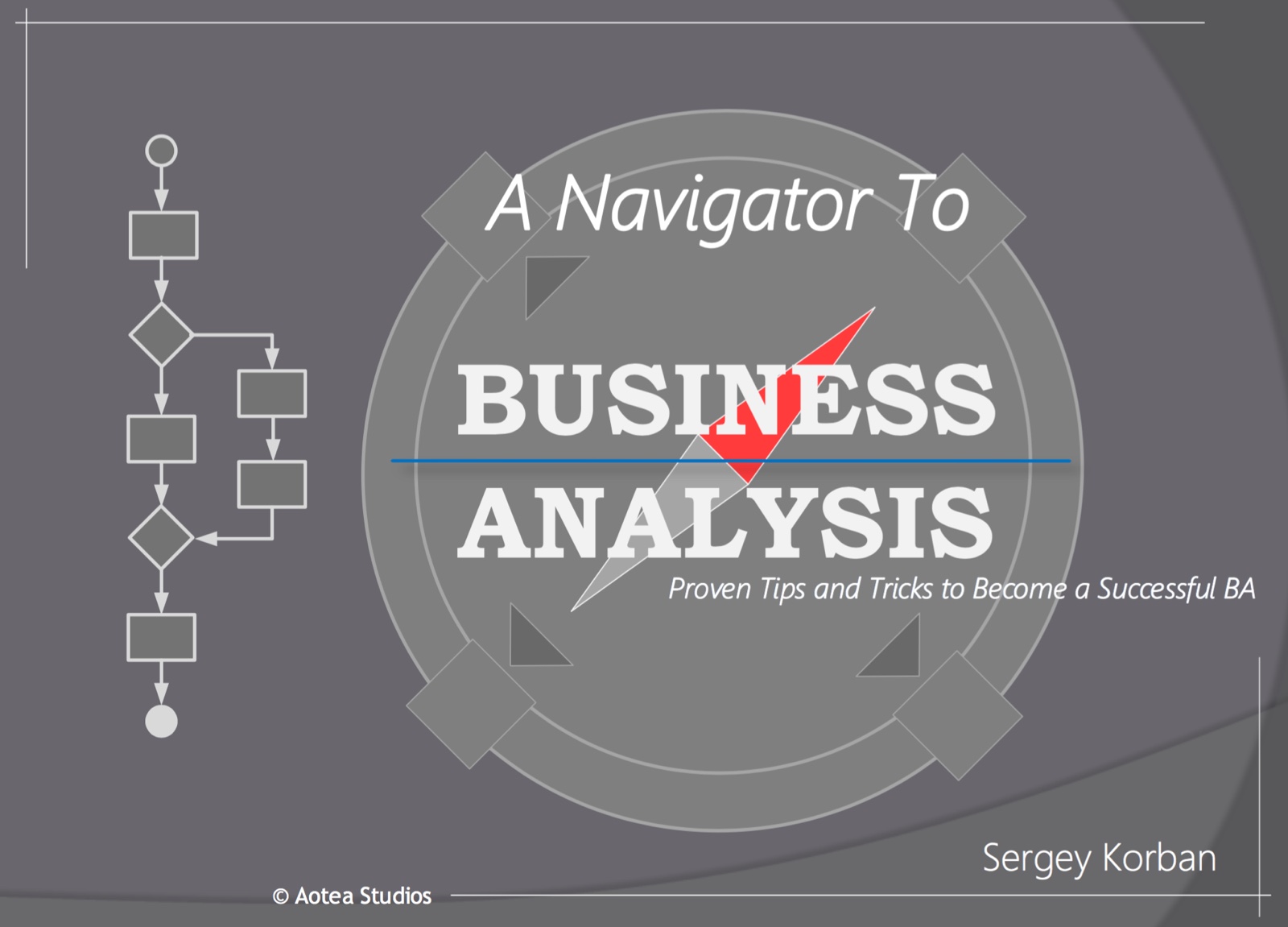A Navigator to Business Analysis
Whether you are just starting out or already have years of experience in the business analysis field, completing BA tasks successfully project after project is a difficult job.
Am I following best practices? Have I covered everything to make this project a success? How can I avoid getting bogged down by my tasks? I’m sure you’ve asked yourself dozens of questions like these.
But with looming deadlines, legacy systems, undocumented processes, busy and distracted stakeholders, it’s hard to find time to work on your skills. It’s especially true when your options consist of long books with an academic bent, and expensive training courses.
Judging by my own experience across many projects, the profession has a rather tall learning curve, even for experienced people, not to mention those who are just starting out in the job. It requires a lot of practice with approach and techniques. You need to learn many tricks to do the job effectively and build your professional value.

What if there was an easier way to boost your skills?
Imagine if there was a business analysis book which was laser-focused on giving you practical advice and tons of tips, making it easy to understand and absorb complex concepts quickly.
A Navigator to Business Analysis
I have condensed decades of practical experience, a dozen books, and countless articles into just one ebook. You can learn quickly with this book.
A Navigator to Business Analysis is a book full of useful tips on communication with business users, obtaining information by observing users’ activities, documenting the results of analysis, getting your point across with visual aids, and more.
It is a new and expanded book which builds on the solid foundation of our previous business analysis guide, BA Kickstart. Here is what people had to say about it:
I loved Kickstart for its concise visual breakdown of the typical BA processes. I am definitely a multi-channel, visual learner and can only consume so much BABOK text before the message gets lost.
Your diagrams really highlight the power of synthesizing information down into a visual model that represents multiple levels of information (system components, workflow, milestones, participants, context etc).
- Ed Garabedian, Business Analyst, Johnson & Wales University, USA
As a senior business analyst, I loved it, as it is a perfect reference manual and a great refresher. I intend to hold on to this document for a long time to come!
I read the document in one go yesterday and at the end of the day felt successful, as you and Sergey were able to refresh my knowledge.
- Jehangir Rizvi, Senior Business Analyst, Australian & New Zealand College of Anaesthetists, Australia
Yes it is excellent!!! I am a visual learner and your start kit will make it easier for me. - Sheela Patel, Business Analyst, USA
Wonderful! I downloaded it and it has the high-quality graphics I was expecting! You guys do excellent work! Thanks very much for your excellent customer service as well!
- Mark DeVries, USA
A Navigator to Business Analysis follows the same successful approach:
- delivers a lot of information through quality visuals
- enables you learn at your own pace
- facilitates quick grasping of new complex knowledge
- saves you time on learning professional tricks
- delivers new effective skills
- gives you great insights into BA techniques
- delivers faster results that can be used in your job straight away.
Check out a sample:
The sample excerpts a section from each part of the book.
Get the ebook now ➡just a $97 investment
Comprehensive view of BA lifecycle and techniques
Part 1 of the book is all about different aspects of business analysis:
Module 1: Business Analysis Overview
What is Business Analysis? ... 12
Business Analysis in Nutshell ... 13
Analysis Planning and Management ... 15
Current State Analysis ... 17
Requirements Gathering ... 19
Requirements Analysis ... 21
Requirements Communication ... 23
Future State ... 24
Solution Evaluation ... 25
Context of Business Analysis ... 26
Revision ... 28
Assignment ... 29
Module 2: Business Analyst's Core Skills
Business Analyst's Core Skills ... 32
Listen ... 33
Watch ... 37
Explore/Read ... 39
Speak ... 41
Write ... 51
Draw ... 53
Link ... 55
Iterate ... 56
Revision ... 57
Assignment ... 58
Module 3: Business Analysis Lifecycle
Business Analysis Lifecycle ... 62
Plan ... 63
Define ... 64
Analyse ... 65
Design ... 66
Build ... 67
Test ... 68
Deploy ... 69
Business Analysis Lifecycle Map ... 70
Module 4: Business Analysis Techniques
Decision Modelling ... 92 Process Modelling ... 113
Document Analysis ... 93 Prototyping ... 114
Estimation ... 94 Requirements Communication Analysis ... 115
Financial Analysis ... 96 Requirements Management Plannning ... 116
Focus Groups ... 97 Reviews ... 117
Functional Decomposition ... 98 Risk Analysis & Management ... 118
Glossary ... 100 Roles & Permissions Matrix ... 119
Interface Analysis ... 101 Root Cause Analysis ... 120
Interview ... 102 Scope Modelling ... 121
Item Tracking ... 103 Sequence Diagram ... 122
Lessons Learned ... 104 Stakeholder List, Map, Personas ... 123
Metrics & KPIs ... 105 State Modelling ... 124
Mind Mapping ... 106 Survey / Questionnaire ... 125
Non-Functional Requirements Analysis ... 107 SWOT Analysis ... 126
Observation ... 109 Use Cases & Scenarios ... 127
Organisational Modelling ... 110 User Stories ... 128
Prioritisation ... 111 Vendor Assessment ... 129
Process Analysis ... 112 Workshops ... 130
Module 5: Business Analysis Techniques, Insights
Pocket Guide ... 134
Strategy of Change ... 135
Requirements Management ... 136
Non-Functional Requirements ... 140
Effective Workshop ... 141
User Story ... 161
Use Case ... 164
Process Analysis ... 170
Personality Types ... 173
Matching Language ... 175
Solution Evaluation ... 176
Module 6: Business Analysis Templates
Introduction ... 180
Business Analysis Templates ... 182
Current State Analysis ... 184
Business Case ... 187
Project Vision ... 190
Requirements Management Plan ... 192
Solution Vision ... 196
Business Requirements ... 198
Use Case Model ... 199
Use Case Specification ... 200
Business Process Design ... 201
Non-Functional Requirements ... 202
Solution Glossary ... 203
Interface Specification ... 205
Revision ... 208
You will understand the core skills required for a business analyst, learn about BA lifecycle, and get introduced to all the relevant techniques used in performing business analysis.
The BA Techniques chapter reflects the changes made to the BABOK® v3.
Part 1 will particularly suit those readers who are considering business analysis as a potential profession, or those making initial steps in a BA career.
More than just business analysis…
To be successful as a BA, you need to understand more than just analysis, and that’s why Part 2 of the book is dedicated to things which aren’t part of the business analysis but are nonetheless essential for a BA to understand:
Module 7: Enterprise Architecture
Enterprise Architecture ... 217
BA's View Of Enterprise Architecture ... 220
Analysis Points ... 221
Enterprise Architecture Principles ... 222
Enterprise Architecture Frameworks ... 223
Module 8: Project Management
Project Management ... 232
Project Context ... 235
Project Collaboration ... 237
Project Management Techniques ... 242
Responsibility Matrix ... 245
Stakeholder Engagement ... 248
Module 9: Service Management
Introduction ... 254
Service Strategy ... 258
Service Design ... 260
Service Transition ... 262
Service Operation ... 264
Service Catalogue ... 266
Module 10: Security Management
Governance Pyramid ... 272
Four P's ... 274
SABSA Framework ... 275
Added Value ... 283
Module 11: Regulation
Internal Regulation ... 287
Interpretation ... 294
External Regulation ... 298
Interpretation ... 300
Module 12: SDLC
Introduction ... 307
SDLC Concept ... 308
SDLC and Business Analysis ... 309
Business Process Analysis ... 310
Requirements ... 312
Requirements in System Development ... 315
System Design ... 320
User Experience ... 321
User Interface ... 326
Unit Test ... 330
Integration Test ... 331
Performance Test ... 333
User Acceptance Test ... 335
Documentation ... 336
Deployment ... 337
In these sections, I give you carefully extracted knowledge about all these areas which is relevant to business analysts. How many books would you have to read to find it all out yourself? Save you all that time and expense!
BONUS Part 3: Building up your value
The first two parts of the book will provide you with a wealth of knowledge, but I didn’t feel that I was quite done after completing them. So I added in a bonus Part 3.
When you read an ad about a business analyst position, you see that certain domain knowledge, and hard and soft skills are required from a candidate. A unique blend of your skills and experience is what makes your CV noticeable in a pile of other CVs.
How can you create that unique blend? What are the key components? Part 3 of the book is focused on answering these questions. Here is the table of contents for it:
Values System ... 343
Focus on Growth ... 344
Negotiation ... 347
Resilience ... 351
Leadership ... 357
Learning Business Domain ... 361
Failures – Lessons Learned ... 366
Keeping Up To Date ... 369
Building Productive Relationships ... 371
Managing Communications ... 372
Behavioral Models ... 374
Engaging Stakeholders ... 380
e-Leadership ... 383
Requirements: Discovery Patterns ... 387
Requirements: Patterns ... 393
Poor Requirements: Impact ... 398
Change Management ... 401
Risk Management ... 403
Issues Management ... 405
Universal Functional Business Model ... 407
User Experience ... 409
Customer Experience Mapping ... 413
Analysis Patterns: Big Data ... 419
Mastering these techniques will help you produce better results and provide more value to your employer.
Start learning today!

For the price of a fancy dinner for two, this book will show you business analysis from a practical, real world perspective and help you crystallise your knowledge. That dinner likely did nothing to improve your career prospects! Investing in your skills, on the other hand, is essential for your career.
| Format | |
| Pages | 435 |
| Money back guarantee | 30 days |
Get the ebook now ➡just a $97 investment

Even so, it may seem like a risk. This is why I offer a 30-day 100% money back guarantee. If you feel like you didn’t get your money’s worth, I’ll refund you. I take all the risk, so there’s no reason for you not to buy!
Save 20%: Buy BA Navigator + BA Template Kit
Business Analysis Template Kit is a comprehensive set of 12 templates which will help you produce better BA documentation. It comes complete with a requirements management plan and a 16-page guide.
Buying BA Navigator and the Template Kit separately would cost you $156 but you can get them as a bundle for just $124 and save 20%!
Want to get the book for the whole team?
If you want all your team members to have access to the book without the hassle of purchasing and tracking individual copies, you can purchase a team licence for the whole team (up to 100 members) for just $499.
About the author
 Hi, I’m Sergey L. Korban, a business analysis practitioner and mentor with over 33 years of field experience.
Hi, I’m Sergey L. Korban, a business analysis practitioner and mentor with over 33 years of field experience.
My experience covers public and private companies in industries such as computer hardware distribution, software retail, automotive (a car dealership chain), ERP systems (business consulting and software development), mobile solutions and utilities.
The projects I have worked on spanned many different areas (compliance, process improvement, business transformation, technology replacement and upgrades, software implementation to name a few).
I live in Wellington, the beautiful and windy capital of New Zealand. I work in the energy sector, delivering compliance, business and technology projects following modern BA, PM, ITIL and Agile methodologies.
I am certified in PRINCE2, ITIL and Agile. I contribute to the BA community through the Aotea Studios blog and many articles illustrating different aspects of business analysis and project management.
I hope that you will get a lot of value out of my book!